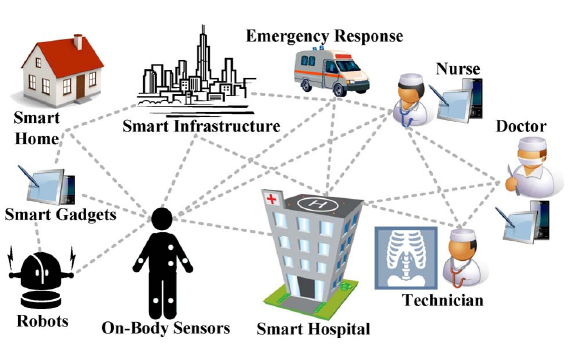A Survey on Ambient Intelligence in Healthcare
By Giovanni Acampora, Diane J. Cook, Parisa Rashidi, and Athanasios V. Vasilakos
NOTE: This is an overview of the entire article, which appeared in the December 2013 issue of the Proceedings of the IEEE.
Click here to read the entire article on IEEEXplore.
This paper surveys ambient intelligence (AI) techniques in healthcare and examines the required infrastructure and technology. Ambient intelligence (AmI) is a new paradigm in information technology aimed at empowering people’s capabilities by means of digital environments that are sensitive, adaptive, and responsive to human needs, habits, gestures, and emotions. This vision of daily environment will enable innovative human-machine interactions characterized by pervasive, unobtrusive, and anticipatory communications.
By relying on various artificial intelligence (AI) techniques, AmI promises the successful interpretation of the wealth of contextual information obtained from embedded sensors, and will adapt the environment to the user needs in a transparent and anticipatory manner. An AmI system is particularly identified by several characteristics: it exploits the contextual and situational information; it is personalized and tailored to the needs of each individual; it can anticipate the needs of an individual without the conscious mediation of the individual; it adapts to the changing needs of the individuals; it is embedded and is integrated into our everyday environments; and, it recedes into the background of our daily life in an unobtrusive way.
Recent advances in sensor networks research are leading to low-cost healthcare monitoring systems embedded within the home and living environments. AmI systems have the potential to greatly enhance the healthcare field. For example, AmI technology can be used to monitor the healthcare status of older adults or people with chronic diseases, and it can provide assistive care for individuals with physical or mental limitations. The infrastructure is made up of three components working together: Body Area Networks (BANs) that collect data on an individual, Wireless Mesh Sensor Networks (WMSNs) for smart living environments, and algorithms that recognize human activities and can flag and respond to abnormal conditions.

Interconnected world of AmI health services.
The widespread use of wireless networks and the constant miniaturization of electrical devices have empowered the development of BANs. In a BAN, various sensors are attached on clothing or on the body or even implanted under the skin. This new communication approach offers numerous new, practical, and innovative applications for improving human health and the quality of life by continuously monitoring health features such as heartbeat, body temperature, physical activity, blood pressure, electrocardiogram (ECG), electroencephalography (EEG), and electromyography (EMG). BANs provide a technological infrastructure for remotely streaming sensored data to a medical doctor’s site for a real-time diagnosis, to a medical database for record keeping, or to corresponding technological equipment that, proactively and autonomously, can issue an emergency alert or intelligently manage this information for taking suitable actions and improving the quality of human life.
The authors acknowledge that, although there are still many challenges to be faced, they are confident that this synergic approach will reach its full application in healthcare and human wellbeing.
ABOUT THE AUTHORS
G. Acampora (giovanni.acampora@ntu.ac.uk) is with the School of Science and Technology, Nottingham Trent University, Nottingham NG11 8NS, U.K.
D. J. Cook (cook@eecs.wsu.edu) is with the Department of Electrical and Computer Engineering, Washington State University, Pullman, WA 99164 USA.
P. Rashidi (parisa.rashidi@ufl.edue) is with the Biomedical Engineering Department, University of Florida, Gainesville, FL 32611 USA.
A. V. Vasilakos (vasilako@ath.forthnet.gr) is with the Department of Computer and Telecommunications Engineering, University of Western Macedonia, Kozani 50100, Greece.






